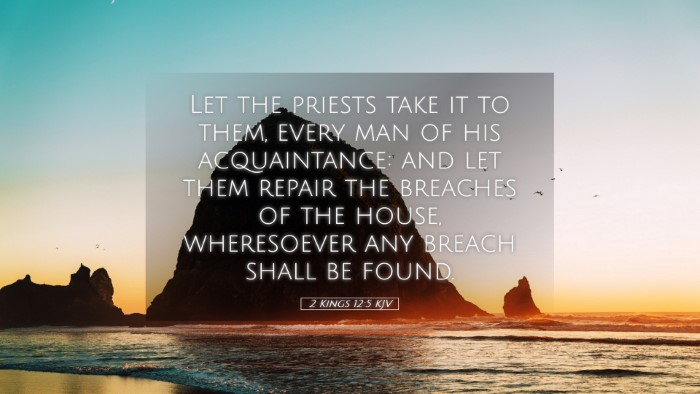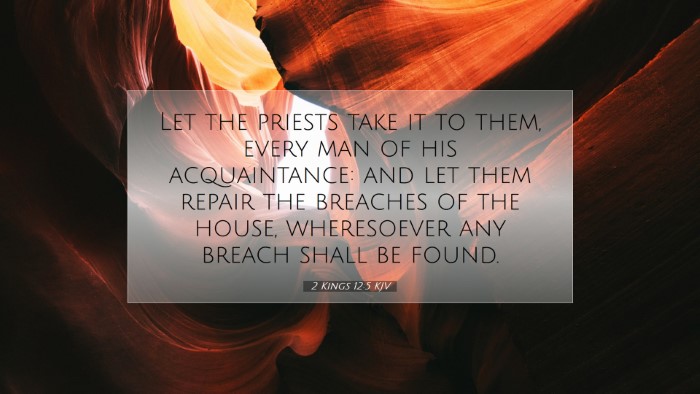Old Testament
Genesis Exodus Leviticus Numbers Deuteronomy Joshua Judges Ruth 1 Samuel 2 Samuel 1 Kings 2 Kings 1 Chronicles 2 Chronicles Ezra Nehemiah Esther Job Psalms Proverbs Ecclesiastes Song of Solomon Isaiah Jeremiah Lamentations Ezekiel Daniel Hosea Joel Amos Obadiah Jonah Micah Nahum Habakkuk Zephaniah Haggai Zechariah Malachi2 Kings 12:5
2 Kings 12:5 KJV
Let the priests take it to them, every man of his acquaintance: and let them repair the breaches of the house, wheresoever any breach shall be found.
2 Kings 12:5 Bible Commentary
Commentary on 2 Kings 12:5
This scripture verse—“And let the priests take it to them, every man of his acquaintance: and let them repair the breaches of the house, wheresoever any breach shall be found”—falls within the historical context of King Joash’s reign over Judah. The verse emphasizes the responsibilities of the priests and the necessity of maintaining the temple, the central place of worship for Israel.
Contextual Background
The context of 2 Kings 12 revolves around Joash's commitment to temple restoration after years of neglect. Following the reign of Athaliah, the temple was in disarray, and idolatrous practices had infiltrated worship. Joash, urged by the priests, overstepped traditional boundaries to ensure the sacred space was preserved.
The Call to Action
In this verse, Joash's directive highlights the communal responsibility towards the temple and, by extension, the worship of Yahweh. The priests were to take initiative and gather funds from the people to repair the temple.
-
Divine Responsibility:
According to Matthew Henry, this action was not merely administrative; it was divinely ordained to restore the sanctity of worship.
-
Spiritual Urgency:
Albert Barnes asserts that the urgency in this directive reflects the seriousness of spiritual decay that resulted from mismanagement and idolatry within the temple's walls.
-
Community Engagement:
Furthermore, Adam Clarke notes that the call for the priests to involve the community is significant in creating a sense of joint accountability in restoring holiness.
The Role of the Priests
The priests are central figures in this narrative. The verse assigns them the task of overseeing the repairs, illustrating their critical role not just as mediators of rituals but as custodians of the worship environment.
-
Responsibility of the Clergy:
Henry suggests that this instruction places a heavy burden on the priests, who must navigate the financial and spiritual implications of such a restoration.
-
Trust and Integrity:
Barnes emphasizes the importance of trust in this process, as the priests were specifically tasked to ensure that funds were used properly, highlighting accountability and integrity in service.
Practical Implications for Today
For modern-day pastors and church leaders, the lessons drawn from 2 Kings 12:5 remain evergreen. Here are some implications:
- Value of Maintenance: Just as the temple required physical upkeep, so do our places of worship require attention, both physically and spiritually.
- Community Involvement: Engaging the congregation in caring for the spiritual house fosters a sense of ownership and commitment to a collective spiritual goal.
- Accountability in Leadership: Leaders must handle resources ethically and transparently, ensuring that the community trusts them with spiritual and financial responsibilities.
Conclusion
2 Kings 12:5 serves as a powerful reminder of our duty to safeguard the spaces where we encounter the divine. The dedication to repair the breaches of the temple reflects God's enduring desire for holiness, community, and responsibility. Just as the priests were entrusted with this sacred task, so too are we called to uphold the integrity and beauty of our spiritual practices and environments today.


